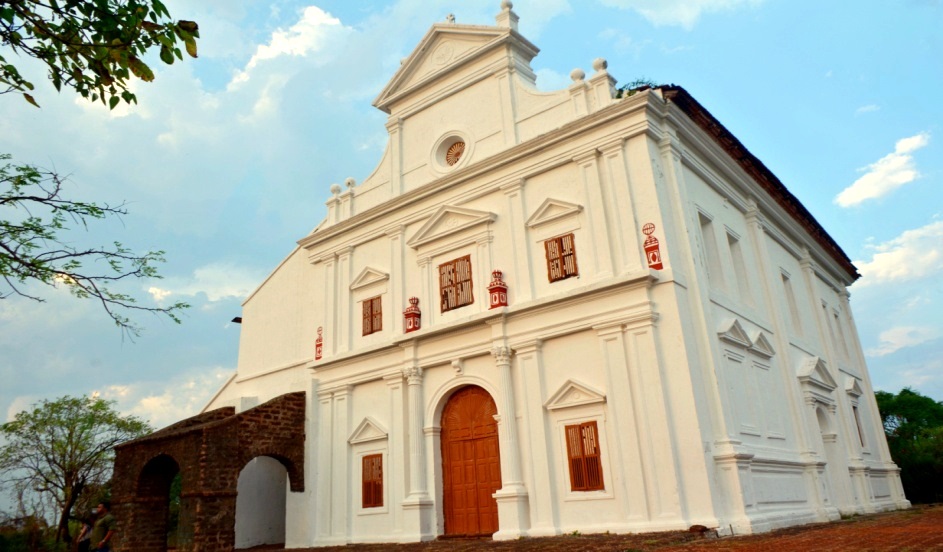
The chapel dedicated to Our Lady of the Mount, Capela de Nossa Senhora do Monte, is one of the oldest chapels in the city of Old Goa. It is located on a small hillock overlooking the Mandovi River. From here, one gets a beautiful view of the city of Old Goa and the surrounding villages.
Earlier, one could reach the chapel by using two flights of steps of stones, called ‘paz’ in Konkani; one from the Corlim side (east) and the other from the Old Goa city side. The eastern flight of steps was destroyed when the Konkan railway was built; some of the steps from the city side too were destroyed to make place for the tarred road to the chapel. Only the last part of the flight, about 100 meters or so, is kept untouched as a historical relic of the past. The chapel yard is now paved with huge solid stones. To the left is a huge Cross.
THE HISTORY
The Portuguese historians of India often made a mention of the Hill as a bulwark of the Mohammedans who had placed their pieces of artillery here. This had caused havoc among the forces of Alfonso de Albuquerque, the second Governor, sent to the East by the King of Portugal to conquer the city of Goa.
To take possession of the city, he launched his first attack in March 1510 from the southern banks of the river Mandovi on Adil Shah of Bijapur, but he was not successful. Then he launched his second attack on November 25 the same year and this time he succeeded.
Realising the importance of this spot, Alfonso de Albuquerque ordered a chapel to be constructed there, which was completed in 1519. There is an inscription in Portuguese on marble on the façade wall, which was put in 1931. It reads thus, “Aqui postou-se a artilharia Maometana contra Alboquerque para retomar Goa em maio de 1510” (Here the Mohammedan artillery stood against Alfonso de Albuquerque to retake Goa in May 1510).
THE CHAPEL
The chapel façade resembles that of the Sè Cathedral. It measures 33 metres in length, 14 metres in breadth, the thickness of the walls 2.7 metres and its roof is covered with Mangalore tiles. Laterite stones are used for the structure and the architectural style is that of Baroque with Mannerist influences.
The walls have three sections; the ground floor section has entrances with windows crowned with triangular pediments on the upper section. This is surmounted by a central panel flanked by wings which hide the gable roof of the chapel.
Down the years, many additions have been made to the chapel, the earliest of which is a two-story loggia attached to the northern wall of the chapel. Against the north-eastern wall and the eastern façade, some extensions were also done which are behind the
altar.
The chapel had outhouses or residences where earlier the chaplain from the Cathedral, who was in charge resided there and looked after the parishioners residing around.
Due to its secluded location, it was in ruins till 2001. Fundação Oriente, an organisation that maintains cultural links between Goa and Portugal, in association with the State government began restoration work. At the moment some restoration work is in progress, hence not accessible for anyone.
THE ALTARS
The chapel had three altars. The main altar is dedicated to Our Lady of the Mount; the side altars were dedicated to St Anthony of Lisboa (or of Padua) and to St Anthony the Hermit. It had a pulpit which was stolen in 1980s since the chapel remained lonely on a hill.
THE FEAST
The feast of the Nativity of the Blessed Virgin Mary is not celebrated here on September 8 but on a Sunday after September 8, preceded by the Novena. This year, it is celebrated on September 10.
When the chapel was a church in the past, daily Mass would be celebrated here. Now, the Mass is celebrated on the 8th of every month. The annual Monte Musical Festival is held here in November. Otherwise for the remaining months of the year, the entire area remains relatively isolated, except for the presence of tourists.
(The writer is Superior at Casa Professa, Basilica of Bom Jesus in Old Goa)